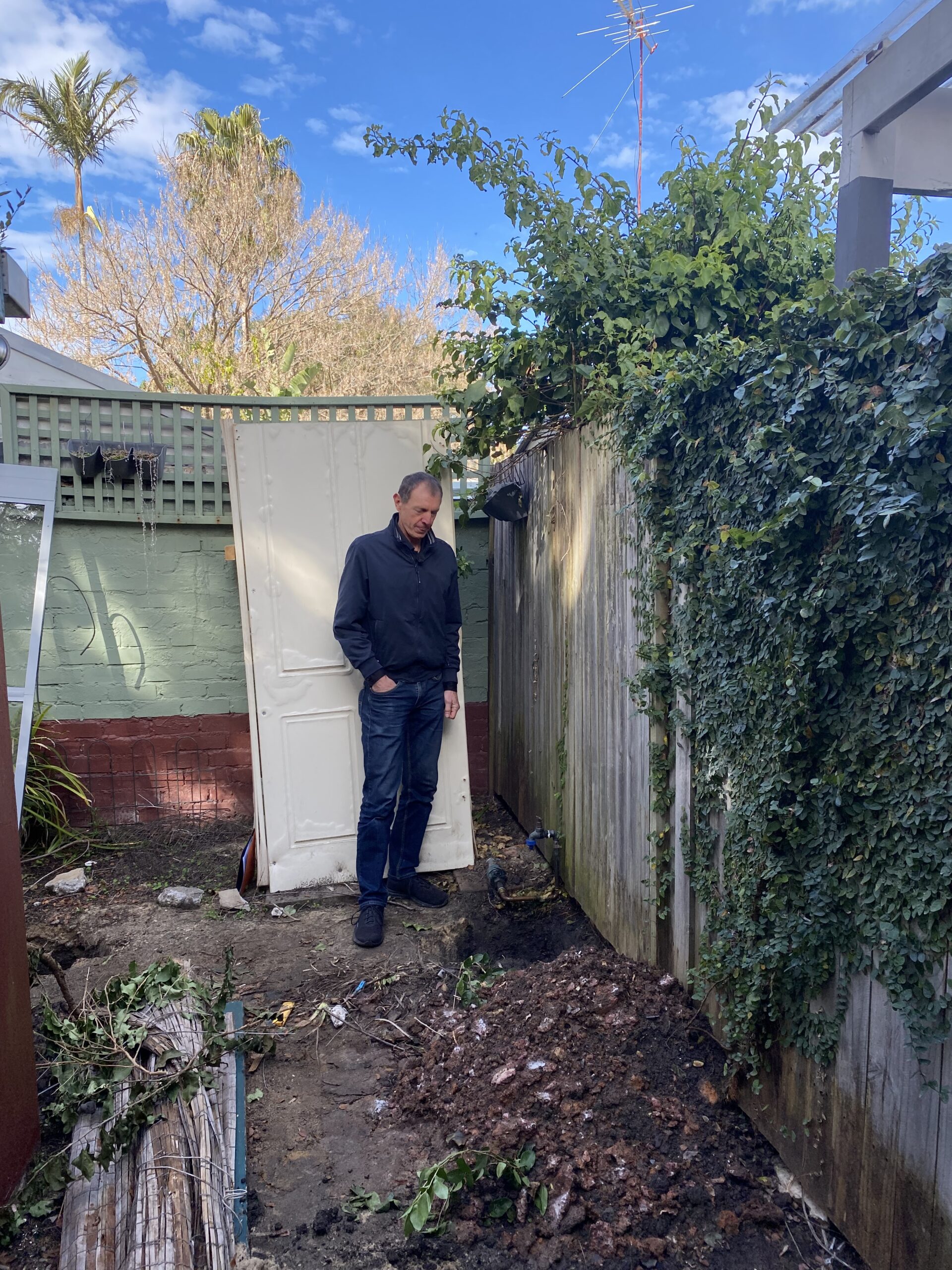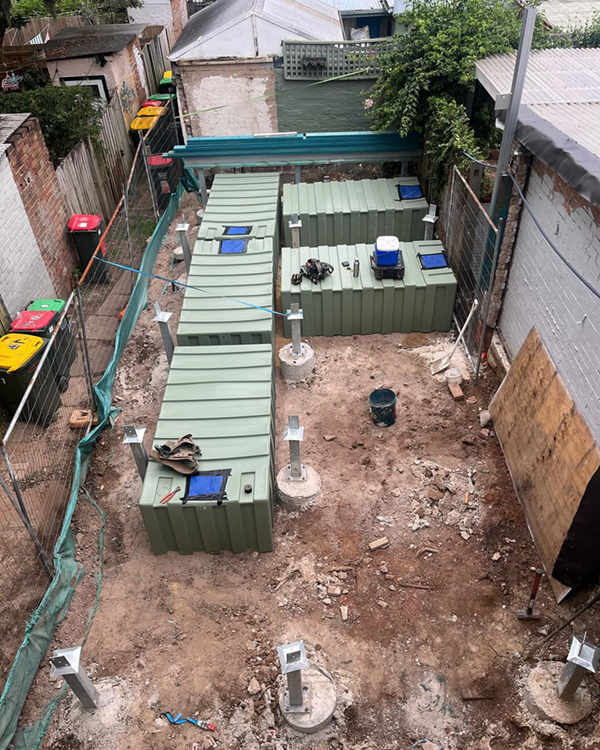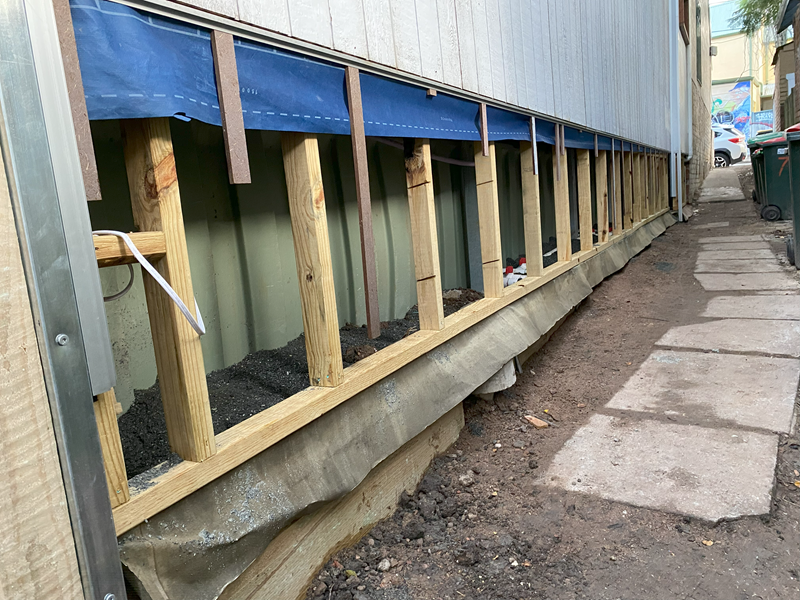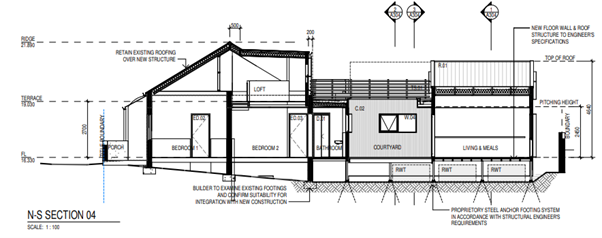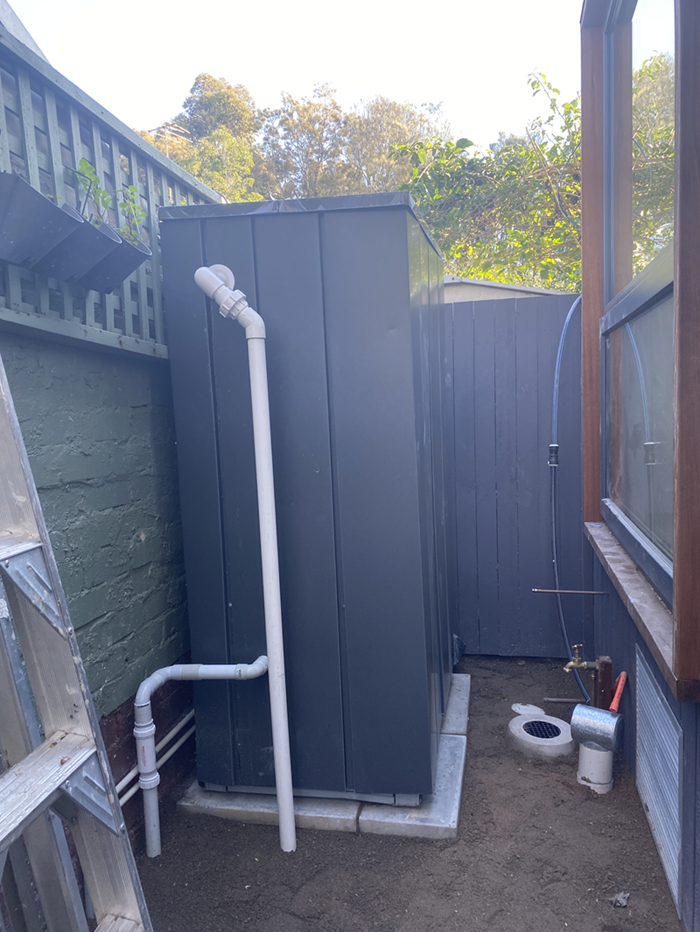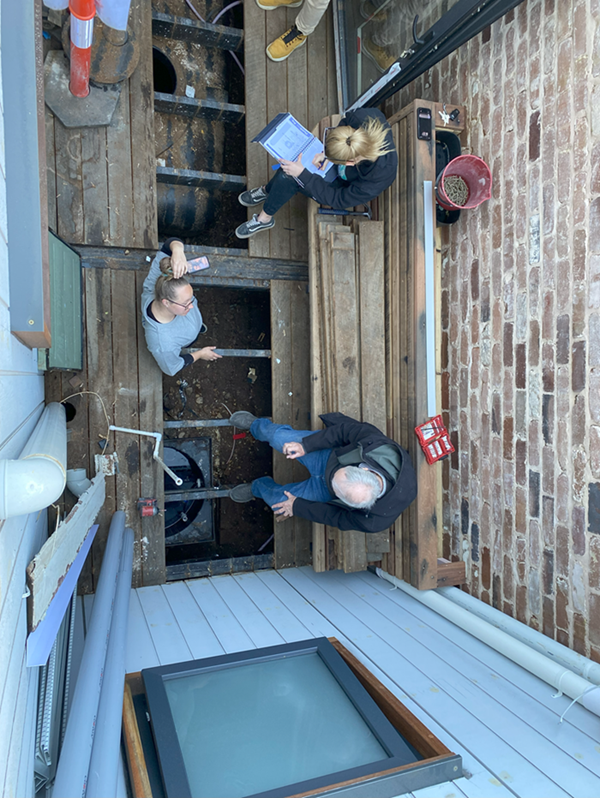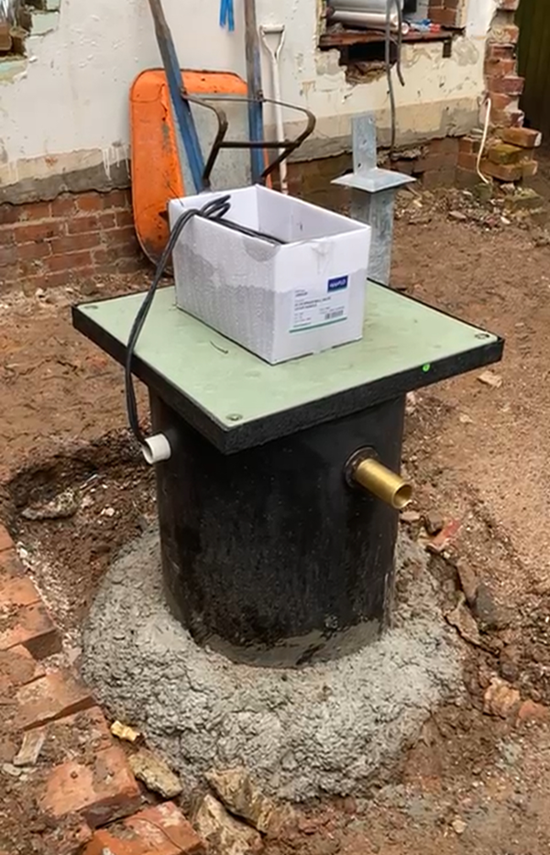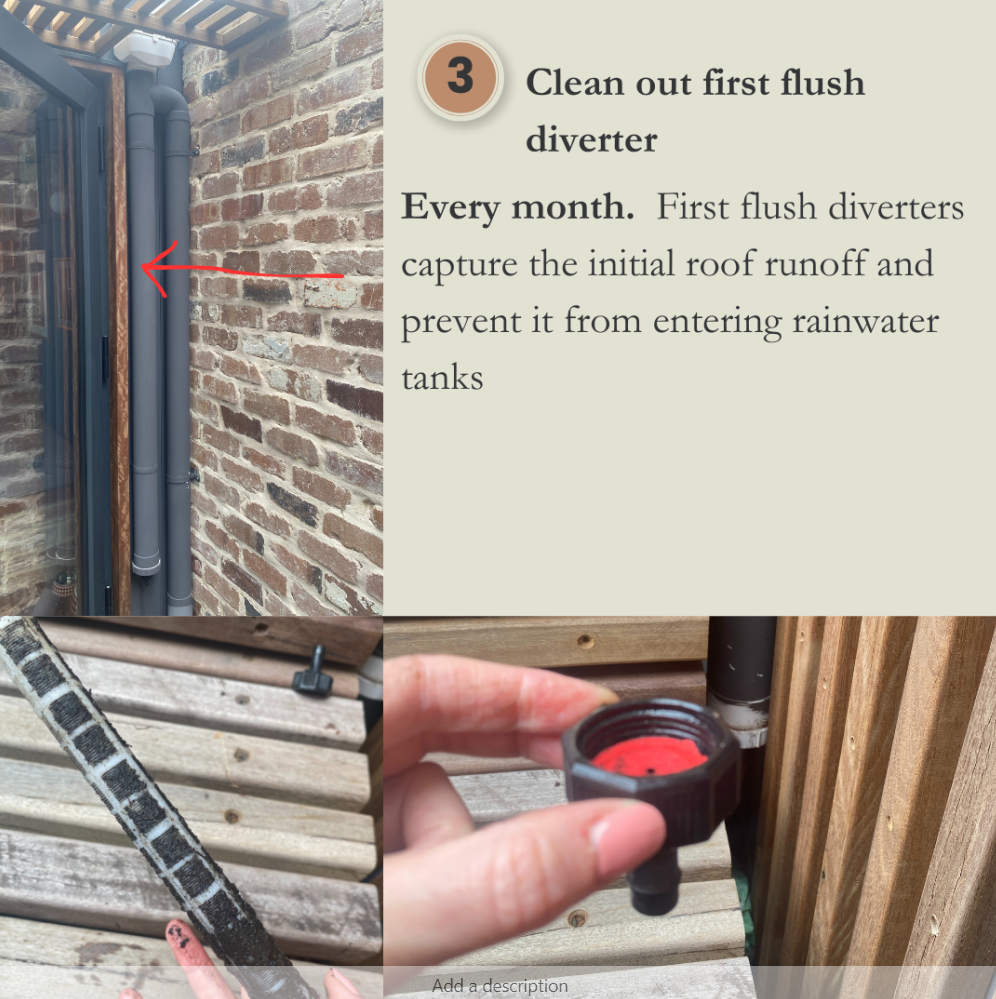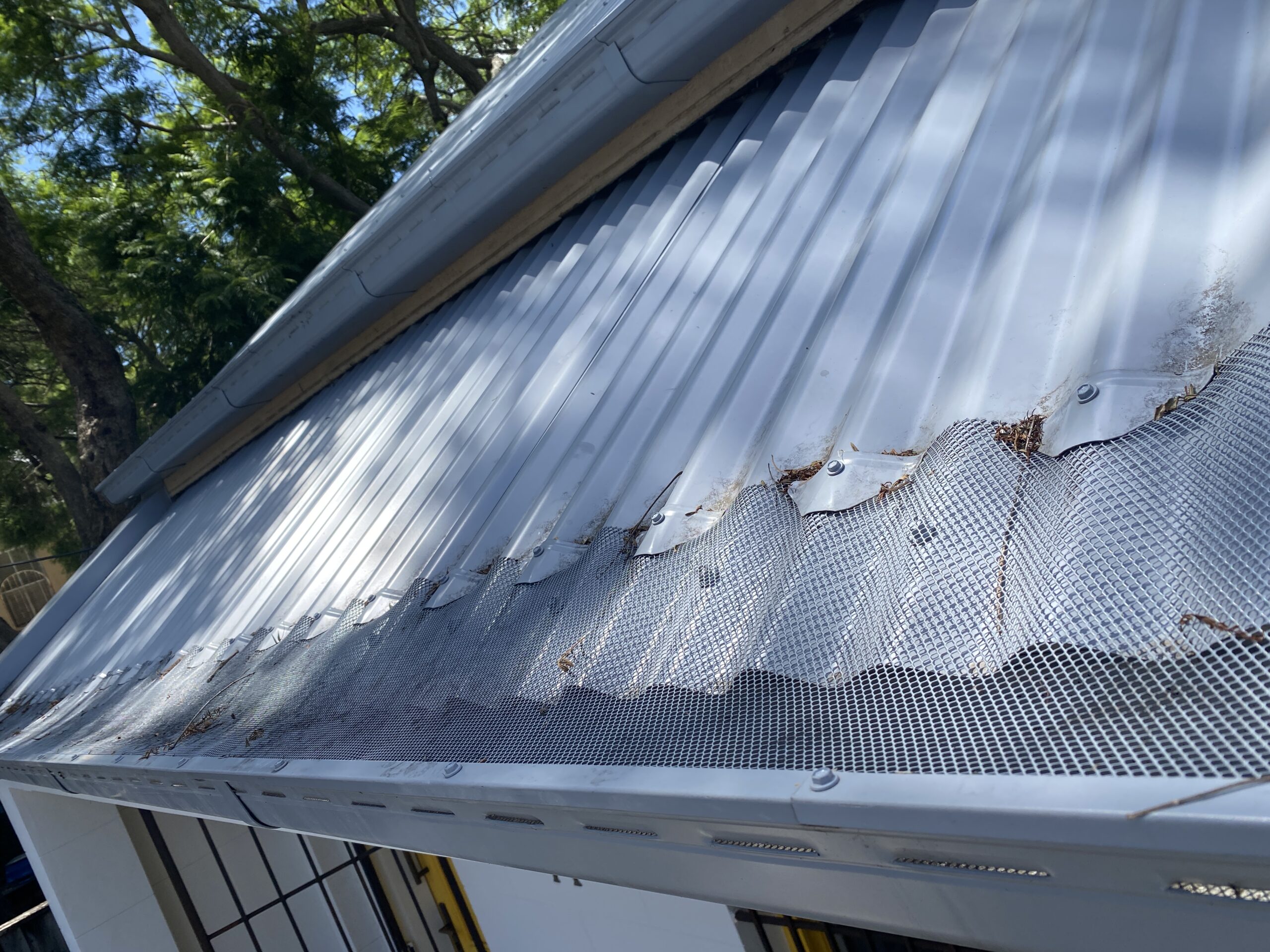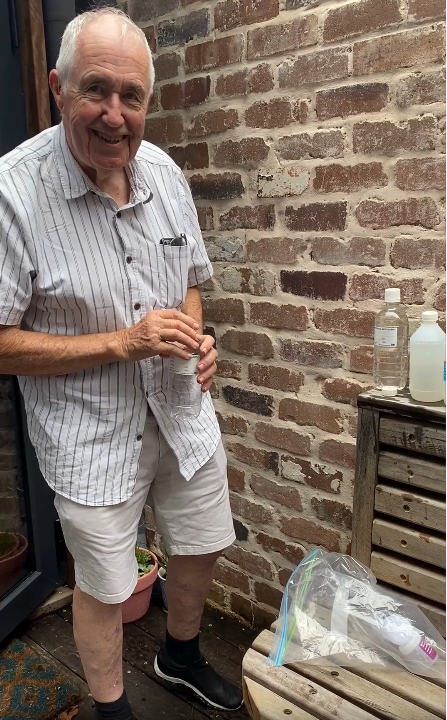Off-Grid Water System Solution
My off-grid water system objectives and solution
Originally when I started this project I had some pretty lofty goals for my water solution. I wanted the ImPossible House to be 100% unconnected to the water mains and stormwater. So completely off-grid! I wanted to demonstrate it could be done in a built-up, established area, on a tiny block. I’m pretty chuffed with this part of the project… we ticked off most of my wish list which was:
My off-grid water system objectives:
- Recycle all water so that it may be reused for drinking, the garden or the washing machine.
- Support a 3-person household (disconnect from the mains)
- No water to leave the property (i.e. disconnected from stormwater).
- The cost of the solution is to be less than $30,000
- The grey water treatment system must satisfy NSW health regulations.
Water Recyling Solution
Now there’s a bit of a story to this part of the project
I searched the globe for people to help me design my water solution. I enrolled in off-grid courses offered by people who had lived in “Earthships” in California, spoke to lots and lots of people who lived off the grid, and emailed anyone I could find that remotely had anything to do with water. This continued for years, and I could never find a workable solution or people told me it was too difficult. And in the end, the guy who ended up helping me design the solution lives up the road in Newtown (John Caley). I started talking to John about my off-grid water challenges around March 2023.
Who is John Caley, and why is he the guy who got the job done?
John Caley was recommended to me by Caroline Pidcock (if you don’t know who she is, then see below). He is an engineer who has designed and is living with a small space solution, which is almost the exact solution I’m looking for. Additionally, John has a business, Ecological Design, which offers assessment, advice, and design services for sustainable residential renovations and builds. He advises on rainwater harvesting, thermal performance, energy audits—all the good stuff.
And who is Caroline Pidcock?
Caroline Pidcock is an Australian architect and a prominent advocate for sustainable development, based in Sydney, New South Wales, and she has provided me with guidance on the Impossible House throughout the project. She is an ambassador for the Al Gore Climate Change and 1 Million Women initiatives– which is a movement of women and girls fighting climate change by taking practical action. She has also held presidential roles with the New South Wales and National Councils of the Royal Australian Institute of Architects. She had an appointment as a Life Fellow of the Royal Australian Institute of Architects in 2006, and she was awarded the prestigious Marion Mahony Griffin Award by the Australian Institute of Architects in recognition of her contribution to architecture in New South Wales. So, I trust her advice and recommendations as we speak the same ‘sustainablilty’ language.
What did John think about my vision?
My brief to John was basically to fulfil the 5 requirements above. Now, if it was up to him, I would remain connected to the water mains for reasons that will become clearer later. But to his credit, he respected my vision.
So, what does the solution look like, and did we tick everything off the wishlist? Well, first, let’s go through the two “parts’ of the solution:
- Water harvesting, storage and filtering
- Water recycling
Water harvesting, storage and filtering
I am frequently asked about my water system and how I will ensure the water is clean and free of bacteria and cryptosporidiosis. John Caley has worked out a system for me that ensures that I won’t end up with any nasty parasites – this is important because my incinerating toilet uses a lot of electricity. So, the less I use it, the better! IF YOU KNOW WHAT I MEAN!
Because I want to be self-sufficient for my water needs. So that means I need ALOTTA TANKS to harvest as much rainwater as possible for drinking (aka potable water)! I’ve got 5 x 2,000-litre tanks. I’m using 2000 Litre Under Deck Water Tanks from Enviro Water Tanks. They’re made from 100% Polyethylene food-grade material. Unfortunately, Polyethylene is sh!tty for the environment:
“While plastic, like polyethylene, brings us convenience, it also threatens environmental sustainability and human health. Due to insufficient recycling, millions of tons of polyethylene pollutants accumulate in terrestrial or marine environments each year. ..The traditional disposal methods include landfilling and incineration. These methods are costly, unsustainable, and further increase the burden on the environment.” Source: Science Direct
My water collection tanks going into the ground
Side access to the water tanks.
John walking me through the water collection tanks once they went in, and how they’ll work.
But here’s the flipside: Polyethylene tanks were more affordable for me than stainless steel tanks. And one big goal of this project is to keep costs down so others might be inspired to copy it.
Water tanks also do a bang-up job reducing flash flooding from stormwater runoff by keeping water close to where it lands, which helps flatten out flood peaks. This brings huge environmental benefits and saves us a stack of cash by reducing damage during severe weather.
Another corker benefit is that water tanks slash the energy needed to treat and pump water to households. Heaps of energy goes into treating and pumping water from big storage facilities to houses, but with each household capturing and storing their own water, we cut down on this energy use big time.
Also, having water tanks in every yard has a couple of ripper effects. First off, if everyone’s got a water tank, it eases the strain on the city’s water supply. This means fewer dams and desalination plants. This whole project has required me to consider many trade-offs. Often, the very best environmental solution has been the most expensive.
I’m not sure if I made the right decision about the tanks, but next time I stupidly decide to build another house like this, I’m hoping there will be improvements in recycling polyethylene and better materials for tanks over time.
The subfloor tank positions.
Tank positioning from the side of the house.
Inside the house, my subfloors have access hatches installed directly above the holes at the top of each tank so they can be cleaned or repaired in future.
It’s pretty rare, but tanks do have leaks sometimes and usually they get replaced. As far as getting access to the tanks to pull them out and replace them in the future, I have the old dunny lane at the side of the house, so we have put access hatches in the side of that subfloor.
My water will undergo a rigorous screening and filtration system that I’ve outlined below (as shown in the infograph below). Let me know if you have any questions or are looking to do something similar yourself.
The Water Filtration System Process
To make my water usable, it goes through the following process:
- 1mm fine gutter screening mesh sits in the gutter to catch all leaves and debris before the water flows down the downpipe.
- Attached to the downpipe is a leaf-shedding rain-head which interrupts the water flowing through the downpipe and catches any debris not caught by the gutter screening mesh.
- As the water hits tank 1, it goes through the first flush diverter.
- The water is then pumped into tanks 2-4, where it waits to be used.
- Garden water comes straight out of tanks 2-4 and doesn’t need more filtration.
- The house water is drawn from the top of tanks 2-4, which is cleaner as any sediment left has fallen to the bottom of the tanks. House water then gets pumped through two sediment filters (a 20-micron and a 5-micron filter) before entering the house and is used for showering, dish and clothes washing, etc.
- Drinking water goes through one more 1-micron filter before being funnelled into the kitchen and bathroom taps.
Grey Water Recycling Sytem
The next part of the solution is the grey water recycling system. And this is where, Roy, Ruby, TJ, Jackson, Aqua Clarus and Roo shine (see the ‘Who we are’ page for more information on this stellar team). The diagram below shows how my water is recycled and reused in the house:
Flow Process:
- Greywater is collected in the below-ground tank, strained, and pumped to the above-ground Aqua Clarus M800sx treatment unit.
- The water is treated through bioreaction, filtration, and UV sterilisation.
- Treated water is stored or used for household purposes. Backflushing ensures membrane cleanliness.
- Solids are discharged into an adsorption trench.
The Aqua Clarus in my back yard
Grey water recycling system process.
Summary of the ACQUA Clarus System
(M800sx Greywater Treatment System)
Purpose: The M800sx is an advanced greywater treatment system designed for homes with up to 4 bedrooms (8 occupants). It treats up to 720 litres per day and can handle peak loads of 1000 litres per day.
Key Components:
- Below-Ground Grey Water Collection Tank:
- Collects and strains greywater, removing debris like hair and lint.
- Above-Ground Treatment Unit:
- Bioreactor: Breaks down organic matter.
- Membrane Filter: Further filters water.
- UV Disinfection Unit: Sterilises water for reuse.
- Treated Water Storage Tank: Stores treated water for household reuse or discharge.
- Pumps and Alarms: Ensures system operation and alerts users to issues.
Additional Information:
The M800sx system is environmentally friendly and highly efficient, using only as much power as a 60W light bulb operating continuously. It avoids harmful chemicals like chlorine, relying instead on cutting-edge membrane and UV filtration technologies. The system is approved for use in NSW and adheres to strict standards for water quality, achieving results such as BOD5 less than 10 mg/L and faecal coliforms below 5 mg/L. Remote monitoring ensures potential issues are detected early, providing peace of mind. Its compact design allows it to fit against a house, making it ideal for domestic installations.
Have I hit my objectives?
So where am I at with my wish list (from the top of the page)?
Number 1. and 2.
Recycle all water so that it may be reused for drinking, the garden or the washing machine, and support a 3-person household.
I’ve turned the mains tap off! My usage bill was a bit fat zero! I’m just paying for the connection at the moment. Sooooo YEP! So next steps are to figure out what I need to do to actually disconnect and then pay nothing for my water!.
Number 3.
No water to leave the property (i.e. disconnected from stormwater).
We didn’t get there on that one.
BUT I’M NOT GIVING UP ON THIS ONE!!
In Sydney we can get 300mm of rain in one day. In weather like that, the runoff from the roof is going to be so big, it will fill up the tanks, and then there’s just no physical way I could keep all the rest of it onsite.
If I had a really big site with sandy, absorbent soil, then John says I could arguably just dispose of that rainwater to subsoil infiltration. But I don’t have the square meterage in my yard for starters, and the ground in my area is very, very non absorptive – it’s clay basically.
And with such a small plot of land, and the house covering almost all of it, we can’t set up any kind of absorption system because those kinds of systems need to be 1.5m at least from the boundary – which is halfway into my house!
Number 4.
The cost of the off-grid water solution is to be less than $30,000 (excluding John’s fee).
WE GOT THERE! With Ruby and the Rose River plumbing team’s fee and the cost of the Aqua Clarus it was almost bang on $30,000. A win!
Number 5.
The system must satisfy NSW health regulations.
NSW Health doesn’t regulate rainwater reuse; they just have guidelines.
Sydney Water says if you’ve got reticulated mains available in the street, you should connect to that – but it’s not a regulation, it’s “advice”.
There is a regulation for greywater treatment that requires you to use an accredited
greywater treatment system. Aqua Clarus ticks that box.
TO CONNECT, OR NOT TO CONNECT
That’s the question. Can I run my off-grid water system without connecting to the mains?
John’s own house runs on rainwater – he believes people should use as much rainwater as they can. But he’s still connected to the mains. At his house, when they have a couple of months where it doesn’t rain at all and their tanks run out, he’s set it up so the system automatically switches to the mains. That hardly ever happens, so only a small percentage of John’s household water comes from mains.
The two images above show the subfloor under John’s kitchen and lounge room with and without the full 6m long 3,000 litre underfloor bladder tank.
It’s based on the idea that humans work best in a community, sharing things like water supply and water treatment, with everyone paying a small amount to have water there when you need it. If you end up needing to use a little bit of mains water or discharge a little bit of treated wastewater, then he thinks it’s good to just be connected and have that backup. It’s there in the street anyway.
My perspective on government infrastructure is a little different which you can read about here in my blog about sewage. I also want to see if I can actually go off grid for water… it’s the challenge!
Something else to ponder.
THE JACARANDA CHALLENGE
Jacarandas are beautiful trees. There’s a big one growing in a neighbour’s backyard and at certain times of the year, it drops a lot of leaves and flowers onto my lot. Those leaves and flowers carry nutrients that will get into the water on my roof. There could be enough of those nutrients to affect the taste of my water; even send it anaerobic.
There are a few ways to deal with that, according to John. Some people just flush it out into the gutter, depending on how much water is in the tank. It’s hard to know how often this anaerobic thing will happen but it will need to be dealt with ongoing. In my case, the water is going to be used continuously by me, and that turnover helps.
Maintenance
This is a rainwater system maintenance guide prepared by John Caley in March 2025. The house runs entirely on rainwater for drinking, showering and via grey water recycling in my laundry and on my garden, so it’s important that the water stays clean, clear and safe.
There’s a jacaranda tree overhanging the roof that drops a lot of leaves and flowers. When that organic matter builds up and gets flushed into the system, it can turn the water brackish, smelly and unpleasant. This guide outlines what I need to do to keep things running properly throughout the year.
1. Key maintenance practices
Here’s what I need to stay on top of to keep the water in good condition:
• Prune back the jacaranda to reduce the amount of leaf and flower fall
• Keep the roof clean with regular sweeping or blowing
• Make sure the gutter mesh, rainheads and first flush diverters are clean and working
• Run aeration pumps in the tanks to keep oxygen levels up (I haven’t done this yet)
• During the heavy drop season, isolate the inlet tank from the rest of the system
Even with all of this, if the water goes off, the only option is to drain the tanks and partially refill with mains water until the system can recover after a clean rainfall.
2. Maintenance schedule
Every Month
• Check and clean gutters and roof
• Clean rainheads and first flush diverters, especially after rain
Every Year
• Isolate the inlet tank while the jacaranda is dropping
• Once flowering ends, clean the roof and gutters, drain the inlet tank and reconnect it
• Check and replace the sediment filters
Every 5 Years
• Check and adjust the pressure in the pressure tank
3. First Flush diverters
• Unscrew black bottom cap
• Slide out filter from inside bottom of diverter
• Clean the hole in the bleed washer
• Clean the filter with spray from hose nozzle and/or old toothbrush
• If the filter is very dirty, unscrew the bottom 100mm cap of the first flush diverter and remove the black ball
• Wash the 100mm cap and ball with water and replace
• Replace filter
• Replace black cap
4. Rainwater filters
Drinking water filter cartridge
Cleanwater Products P/N. MC-ULTRAD-10 – ULTRA-D CARB 9 3/4″ x 2.5” FILTER
Sediment Filters:
First (upstream): UNICEL PLEATED 20” x 4.5” 20 MICRON NOM. PLEATED SEDIMENT CARTRIDGE
Second: UNICEL PLEATED 20” x 4.5” 5 MICRON NOM. PLEATED SEDIMENT CARTRIDGE
Filter replacement steps:
• Turn off minicocks/tap on supply to filter
• Unscrew filter housing using removal tool
• Replace filter cartridge
• Replace filter housing (with new cartridge inside)
• Open valves both sides of the filters
• Source new filter cartridges
Make sure the gutters stay clear – especially from Jacaranda flowers
5. Gutters/Roofs
Check for built up leaves/flowers and remove with a hand broom and gloves or leaf blower.
6. Leaf-Shedding Rainheads
• Check for build-up of material on the rainhead screen
• Remove the screen and tip any built-up material into the garden
• Replace the screen
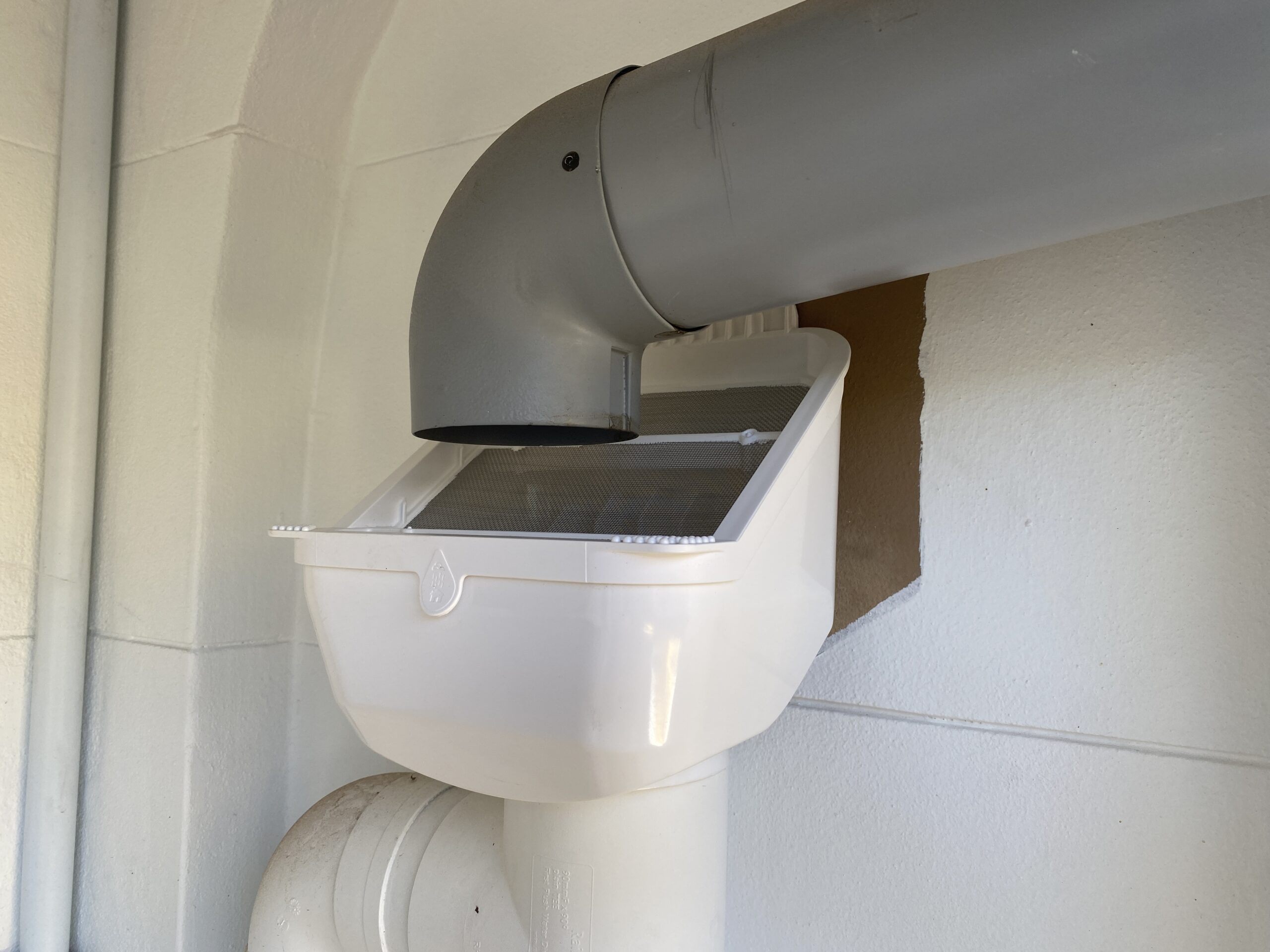
Leaf shedding rain head
7. TANKS
Isolating the inlet tank
• Unscrew and remove side lane access panel to subfloor
• Close the ball valve on the pipe connecting the inlet/outlet tank to all the other tanks
Draining the inlet tank
• Isolate the inlet tank (see above)
• Open the ball valve allowing the tank to drain out into the lane
• Close the ball valve on the pipe to the lane.
8. Pressure Tank
• Turn off power to the pump
• Close mains water tap
• Open a tap that uses rainwater (e.g. kitchen sink) until water flow stops
• Put pressure gauge on valve of pressure tank
• Use an air pump (bicycle or car) to add air as required to 335 kPa (50 psi)
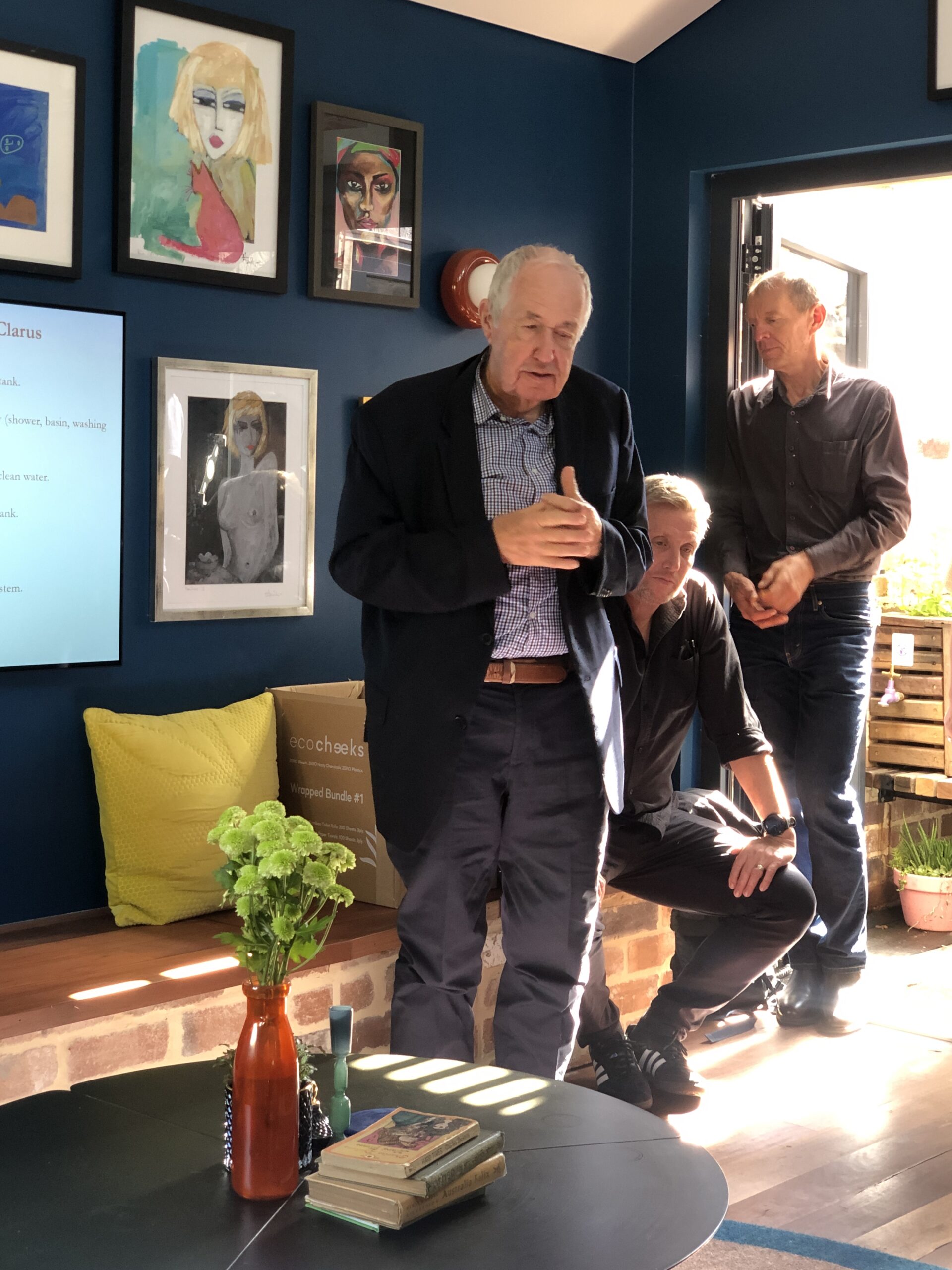
Roy (Aqua Clarus Inventor), Paul my architect and John who designed the rainwater harvesting system. They were all speaking during sustainable house day 4 May 2025 at the ImPossible House
Water Testing
I’m O FEACALLY Approved
Roy, everyone’s favourite inventor, tested the treated greywater coming out of the Aqua Clarus greywater system.
The lab results are in
And I’m chuffed to report I O FEACALLY PASSED
I’m not good at jokes
Here’s how the system performed against the Aqua Clarus standards
CBOD (Carbonaceous Biochemical Oxygen Demand)
CBOD is a fancy way of saying how biologically clean your water is. It measures how much oxygen would be needed to break down organic matter in the water.
Lower = cleaner.
Mine came in at less than 5 mg/L
Well under the 20 mg/L benchmark
Turbidity and suspended solids
Turbidity and suspended solids (if ya know what I mean) were also super low
That means the water is clean, clear, and won’t clog anything up
YESSSS and also WOOOT
And so
Yes
I’m officially, proudly, Faecally Approved

